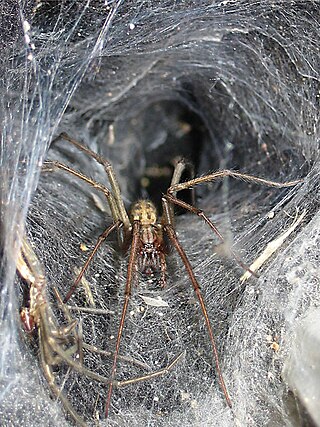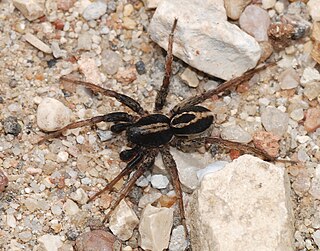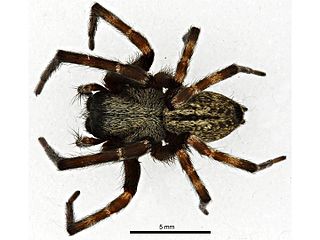
Desidae is a family of spiders, some of which are known as intertidal spiders. The family is named for the genus Desis, members of which live in a very unusual location — between the tides. The family has been reevaluated in recent years and now includes inland genera and species as well, such as Badumna and Phryganoporus. In 2017, the family Amphinectidae was merged into Desidae. The family Toxopidae has been separated off. Those intertidal spiders that are truly marine commonly live in barnacle shells, which they seal up with silk; this allows them to maintain an air bubble during high tide. They emerge at night to feed on various small arthropods that live in the intertidal zone.

The Agelenidae are a large family of spiders in the suborder Araneomorphae. Well-known examples include the common "grass spiders" of the genus Agelenopsis. Nearly all Agelenidae are harmless to humans, but the bite of the hobo spider may be medically significant, and some evidence suggests it might cause necrotic lesions, but the matter remains subject to debate. The most widely accepted common name for members of the family is funnel weaver.

Amaurobiidae is a family of three-clawed cribellate or ecribellate spiders found in crevices and hollows or under stones where they build retreats, and are often collected in pitfall traps. Unlidded burrows are sometimes quite obvious in crusty, loamy soil. They are difficult to distinguish from related spiders in other families, especially Agelenidae, Desidae and Amphinectidae. Their intra- and interfamilial relationships are contentious. According to the World Spider Catalog, 2023, the family Amaurobiidae includes 286 species in 50 genera.

Cribellum literally means "little sieve", and in biology the term generally applies to anatomical structures in the form of tiny perforated plates.

Stiphidiidae, also called sheetweb spiders, is a family of araneomorph spiders first described in 1917. Most species are medium size and speckled brown with long legs. All members of this family occur in New Zealand and Australia except for Asmea. They build a horizontal sheet-like web under rocks, hence the name "sheetweb spiders".

The Agelenoidea or agelenoids are a superfamily or informal group of entelegyne araneomorph spiders. Phylogenetic studies since 2000 have not consistently recovered such a group, with more recent studies rejecting it.
The Dictynoidea or dictynoids are a group of araneomorph spiders that have been treated as a superfamily. The composition of the group has varied. Phylogenetic studies in the 21st century have failed to confirm the monophyly of the dictynoids as originally defined.
Cambridgea elegans is a species of spiders in the genus Cambridgea found in New Zealand.

Cambridgea decorata is a species of spiders in the genus Cambridgea found only in New Zealand. It is classified as "data deficient" under the New Zealand Threat Classification System. The only published records are of specimens collected in the 1940s from Parnell, and Waiheke Island (females). Both localities are in Auckland.

The RTA clade is a clade of araneomorph spiders, united by the possession of a retrolateral tibial apophysis – a backward-facing projection on the tibia of the male pedipalp. The clade contains over 21,000 species, almost half the current total of about 46,000 known species of spider. Most of the members of the clade are wanderers and do not build webs. Despite making up approximately half of all modern spider diversity, there are no unambiguous records of the group from the Mesozoic and molecular clock evidence suggests that the group began to diversify during the Late Cretaceous.
Corasoides is a genus of South Pacific intertidal spiders that was first described by Arthur Gardiner Butler in 1929. Originally placed with the Agelenidae, it was moved to the Stiphidiidae in 1973, and to the Desidae after a 2017 genetic study.

Ischalea is a genus of intertidal spiders that was first described by Ludwig Carl Christian Koch in 1872. As of September 2019 it contains three species, found in Mauritius, on Madagascar, and the Polynesian Islands: I. incerta, I. longiceps, and I. spinipes. Originally placed with the Pisauridae, it was moved to the Stiphidiidae in 1973, and to the Desidae after a 2017 genetic study.

Nanocambridgea is a monotypic genus of intertidal spiders containing the single species, Nanocambridgea gracilipes. It was first described by Raymond Robert Forster & C. L. Wilton in 1973, and is found on New Zealand. Originally placed with the Stiphidiidae, it was moved to the Desidae after a 2017 genetic study. A male described as N. grandis in 2000 was synonymized with Cambridgea reinga in 2011.

Badumna longinqua or the grey house spider is a species of spiders in the family Desidae. Native to eastern Australia, it has been introduced into New Zealand, Japan, the United States, Mexico, and Uruguay.

Toxopidae is a small family of araneomorph spiders, first described in 1940. For many years it was sunk into Desidae as a subfamily, although doubts were expressed as to whether this was correct. A large-scale molecular phylogenetic study in 2016 led to the family being revived.

Cambridgea foliata, commonly known as New Zealand sheet-web spider, is a species of spider in the family Desidae. These nocturnal, arboreal spiders are endemic to the North Island of New Zealand and build large horizontal sheet-webs with a large number of knock-down threads.
Muritaia suba is a species of araneomorphae spider of the family Amaurobiidae, endemic to New Zealand. Its cephalothorax, legs, and chelicerae are a pale reddish brown, while the abdomen is pale yellow brown and has irregular black shading down the dorsal surface.













